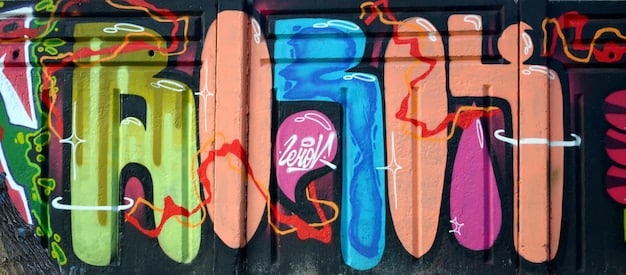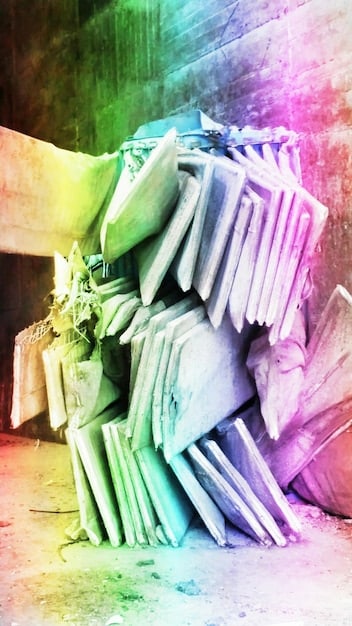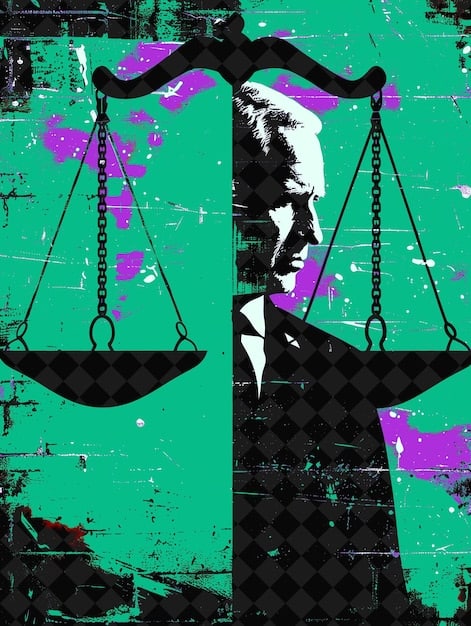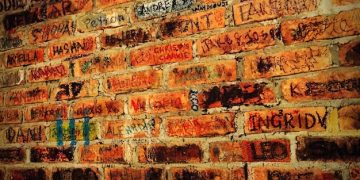US Copyright Law 2025: Impact on Graffiti Artists’ Rights

The updated 2025 US Copyright Law is poised to significantly reshape intellectual property protections for graffiti artists, potentially clarifying ownership, enforcement, and fair use boundaries within this evolving art form, thereby influencing its commercial and cultural future.
As the vibrant strokes of graffiti art increasingly adorn our urban landscapes, a complex question emerges: how will the updated 2025 US Copyright Law impact graffiti artists’ rights? This query is not merely academic; it delves into the very core of artistic ownership, creative expression, and the often-contentious relationship between public art and intellectual property. Understanding these changes is crucial for artists, collectors, and the legal professionals navigating this nuanced terrain.
The Evolving Landscape of Copyright and Street Art
The intersection of copyright law and street art, particularly graffiti, has long been a source of legal contention and artistic debate. Historically, graffiti was largely considered ephemeral and unauthorized, existing outside traditional legal protections. However, as public perception shifts and the commercial value of street art gains recognition, the need for clear intellectual property guidelines becomes increasingly vital. This evolving legal landscape seeks to balance artists’ rights with public interest and property ownership.
Artists who create on public or private property without explicit permission often find themselves in a precarious legal position. While their work might display immense creativity and skill, its unauthorized nature can complicate any claim to copyright. This ambiguity has led to numerous legal battles, highlighting the desperate need for clearer definitions and processes. The updated 2025 US Copyright Law aims to address some of these long-standing issues, potentially providing a more defined framework for intellectual property in this dynamic field.
Understanding the Visual Artists Rights Act (VARA) and Its Limitations
The Visual Artists Rights Act (VARA) of 1990 was a landmark piece of legislation, granting certain moral rights to creators of “works of visual art.” These rights include the right to attribution and, crucially for street artists, the right to prevent distortion, mutilation, or modification of their work that would be prejudicial to their honor or reputation, and to prevent any destruction of a work of recognized stature. While VARA has been a significant tool for artists, its application to graffiti has not been without controversy.
There have been notable cases where VARA was successfully invoked by graffiti artists whose work was destroyed or altered. These victories have often hinged on proving the “recognized stature” of the artwork, a subjective and often challenging criterion to meet in a courtroom. Critics argue that VARA’s scope is too narrow, typically protecting only specific types of visual art and often failing to consistently encompass the unauthorized nature of much graffiti. The interpretation of “recognized stature” also varies widely, leading to inconsistent legal outcomes. For traditional art, this
might involve gallery exhibitions or critical acclaim, but for street art, it poses unique challenges.
- Right to Attribution: Graffiti artists can claim authorship of their work.
- Right to Integrity: Protection against destruction or alteration of works of recognized stature.
- Challenges in Application: “Recognized stature” is often difficult to prove for ephemeral street art.
The Digital Realm: NFTs and Copyright Challenges
The advent of Non-Fungible Tokens (NFTs) has introduced another layer of complexity to copyright law for street artists. NFTs purport to establish digital ownership of unique assets, including digital representations of physical artwork. For graffiti artists, minting an NFT of their work could theoretically provide a new avenue for monetization and ownership claims, but it also raises new legal questions. Can an artist NFT an artwork that was created illegally on someone else’s property? Does owning an NFT of a graffiti piece confer any rights over the physical artwork itself, especially if the physical artwork is subject to removal or destruction by property owners?
These questions highlight the tension between digital ownership and physical rights. While an NFT might provide a verifiable record of a digital asset’s uniqueness, it does not inherently supersede existing copyright law or property rights. Legal scholars are actively debating how existing copyright frameworks apply to NFTs, and the 2025 updates may offer some clarity. However, the unique, often unauthorized nature of graffiti art complicates these discussions significantly, demanding careful consideration of precedent and future implications.
Key Provisions of the 2025 US Copyright Law Amendments
The anticipated amendments to the US Copyright Law in 2025 are expected to bring several significant changes that could directly or indirectly impact graffiti artists. While the full scope of these changes will only become apparent upon implementation, legal experts anticipate clarifications in areas such as digital rights, fair use, and the concept of “fixed” works. These updates aim to modernize copyright protections in an increasingly digital world, but their application to the unique circumstances of graffiti art warrants close examination.
One crucial area of focus is likely to be the clarification of what constitutes a “fixed” work. Traditionally, copyright protection is granted to original works of authorship fixed in a tangible medium of expression. For street art, particularly graffiti, the “tangible medium” is often a public wall or structure, leading to debates about the permanency and legality of its fixation. If the new law offers clearer definitions or exceptions for works created in public spaces, it could significantly alter how graffiti art is treated under intellectual property law.
Strengthening Digital Copyright Enforcement
The digital age has made it easier than ever to reproduce and disseminate images of artwork, including graffiti, often without the artist’s permission. The 2025 amendments are likely to include stronger provisions for digital copyright enforcement, providing artists with more robust tools to combat unauthorized use of their work online. This could manifest as streamlined take-down procedures for infringing content on social media and other digital platforms, or enhanced penalties for commercial exploitation of copyrighted images.
For graffiti artists who rely on photographic documentation and online sharing to showcase their work, these strengthened enforcement mechanisms could be a double-edged sword. While it offers protection against commercial misuse, it also raises questions about the common practice of documenting and sharing street art by the public. The law will need to strike a delicate balance between protecting creators and maintaining the public’s ability to engage with and record works in public spaces.
- Faster Takedown Notices: Streamlined procedures for removing infringing digital content.
- Increased Penalties: Harsher consequences for commercial digital copyright infringement.
- Balancing Public Use: Addressing the complexities of sharing public art online.
Clarifying Fair Use and Public Domain
The doctrine of fair use allows for limited use of copyrighted material without permission for purposes such as commentary, criticism, news reporting, teaching, scholarship, or research. The updated law might offer clarifications on what constitutes fair use, particularly in the context of commercial entities using images of street art in advertising or merchandise. Currently, the application of fair use to images of public art can be ambiguous, leading to disputes between artists and corporations.
A clearer definition could prevent undue exploitation of artists’ work while still allowing for legitimate public and academic uses. Furthermore, the concept of public domain, where works enter a status where they are no longer protected by copyright and can be freely used by anyone, might also see adjustments. These clarifications are vital for establishing clear boundaries for artists and those who interact with their work, ensuring that economic benefits accrue fairly to creators.

Implications for Graffiti Artists: Opportunities and Challenges
The updated 2025 US Copyright Law presents a complex interplay of opportunities and challenges for graffiti artists. On one hand, stronger copyright protections could empower artists to assert their rights, potentially leading to fairer compensation for the commercial use of their work. On the other hand, expanded enforcement could also lead to more litigation against unauthorized art or unintended restrictions on public appreciation and documentation.
The nuances of the new legislation will likely dictate whether these changes foster a more supportive environment for street artists or create additional legal hurdles. Artists might need to become more proactive in registering their works with the U.S. Copyright Office, a step that traditionally has not been common practice for graffiti art due to its ephemeral and often illicit nature. Legal guidance will be paramount for artists seeking to navigate this evolving landscape.
Increased Legal Recourse and Monetization Opportunities
One of the most significant opportunities for graffiti artists under the new copyright law could be increased legal recourse against unauthorized commercial exploitation. If the amendments clarify that even unauthorized public art can be copyrightable, artists might have a stronger standing to sue companies that use their work in advertisements, products, or other commercial ventures without permission or compensation.
This could open up new avenues for monetization, allowing artists to license their existing works or negotiate fees for future projects. Such a development would fundamentally shift the power dynamics, giving artists more control over their intellectual property and potentially legitimizing street art as a valuable asset within the broader art market. It could also encourage more commissioned work, as corporations might prefer to license art legally rather than risk copyright infringement lawsuits.
Potential for Greater Liability and Restrictions
Conversely, strengthened copyright laws also carry the potential for greater liability for artists. While the current focus is on protecting artists, the very act of creating graffiti on property without permission remains illegal in many jurisdictions. If the law unequivocally grants copyright to unauthorized works, it could inadvertently acknowledge their legal existence in one sense, while they remain illegal in another. This paradoxical situation might lead to increased legal action against artists, particularly by property owners seeking removal or damages.
Furthermore, stricter enforcement might lead to greater restrictions on where and how graffiti can be created, pushing artists further underground or into legal gray areas. The tension between artistic freedom and property rights will likely intensify, requiring careful navigation by both artists and legal professionals. The law must strive to protect artistic expression without undermining legitimate property ownership rights.
The Role of Property Owners and Public Space
The core conflict surrounding graffiti art and copyright often revolves around the rights of property owners versus the rights of artists. If a work of art is created on someone else’s private property without permission, who holds the ultimate authority over that work? The updated 2025 US Copyright Law will need to carefully consider this dynamic, aiming to prevent unintended consequences for property owners.
For public spaces, the considerations are equally complex. Public art is often seen as a gift to the community, contributing to the cultural fabric of urban environments. However, even in public spaces, there are typically custodians or governmental entities responsible for their maintenance. The law must clarify whether these entities acquire any rights over copyrighted art within their domain, and under what circumstances they can alter or remove it without infringing on the artist’s rights.
Defining Ownership and Permission Thresholds
A crucial aspect of the forthcoming amendments will be the clarification of ownership and permission thresholds. Will the law differentiate between authorized and unauthorized graffiti, granting different levels of copyright protection? For instance, art created with explicit permission on a commissioned mural might have stronger protections than a spontaneous tag on an abandoned building.
Defining these thresholds is critical for both artists and property owners. Clear guidelines would reduce ambiguity and potential litigation. Property owners might need new legal frameworks for dealing with unauthorized art on their property, including whether they acquire any rights to reproduce or destroy it without permission from the copyright holder. This could necessitate new contractual agreements or legislative updates at the local level to align with federal copyright changes.
- Authorized vs. Unauthorized Art: Different legal treatments based on consent.
- Property Owner Rights: Clarification on ability to remove or use unauthorized art.
- Commissioned Works: Stronger protections for art created with explicit permission.
Preserving and Erasing: The Ethical and Legal Dilemma
The debate between preserving street art and permitting its destruction often comes down to differing views on its intrinsic value and its legal standing. Property owners have a legitimate interest in maintaining their property and removing unwanted art. However, if that art gains “recognized stature” under VARA or broader copyright principles, its destruction could constitute an infringement.
The updated law must consider how to balance the rights of preservation with the practicality of urban maintenance. Could there be legal mechanisms for temporary injunctions to prevent destruction, or requirements for notice to artists before removal? These questions are particularly salient for works that are widely celebrated or gain significant cultural recognition, presenting an ethical and legal dilemma that extends beyond mere property law into the realm of cultural heritage.

Case Studies and Precedents: Lessons from the Past
Examining past legal battles involving graffiti art and copyright provides valuable insights into the challenges and complexities that the 2025 US Copyright Law aims to address. Cases like the 5Pointz dispute in New York City have served as crucial precedents, highlighting the significant financial and cultural implications of destroying street art. These cases underscore the urgent need for clear legal frameworks that protect artistic expression without undermining property rights.
The outcomes of these landmark cases often depended heavily on the interpretation of existing copyright statutes, particularly VARA, and the ability of artists to prove the “recognized stature” of their work. While some artists have achieved legal victories, these wins often resulted from lengthy and expensive litigations, demonstrating the difficulty of enforcing rights in a largely undefined legal territory. The lessons learned from these cases will undoubtedly inform the application and interpretation of the updated copyright law.
The 5Pointz Case: A Landmark for Moral Rights
The dispute surrounding 5Pointz, a renowned graffiti mecca in Long Island City, New York, stands as a pivotal moment in the legal history of street art. In 2013, the property owner whitewashed over hundreds of murals without providing the artists with the 90-day notice required by VARA for works of “recognized stature.” The artists sued, and in 2018, a federal judge ruled in their favor, awarding them $6.7 million in damages.
This case was a landmark victory because it affirmed that even unauthorized graffiti could be considered a “work of recognized stature” under VARA, thereby granting its creators moral rights, including protection against destruction. The ruling underscored that the commercial success or public recognition of street art can be a strong indicator of its stature. This precedent suggests that unauthorized art, if it achieves a certain cultural standing, may receive significant protection under federal law.
Other Notable Cases and Their Impact
Beyond 5Pointz, several other cases have shaped the discourse around graffiti copyright. These include instances where graffiti artists successfully sued companies for using their work without permission in advertising campaigns, or cases where artists sought to prevent the alteration of their murals. Each case contributes to a growing body of legal interpretation, offering glimpses into how courts are grappling with these novel issues.
These cases consistently highlight the tension between the ephemeral nature of street art and the enduring protections of copyright law. They also illuminate the varying degrees of success artists have had in asserting their rights, often contingent on factors such as the visibility of the artwork, the artist’s reputation, and the specific facts of each dispute. The collective impact of these precedents demonstrates a slow but steady shift towards recognizing the intellectual property rights inherent in street art.
Preparing for the Changes: Advice for Artists and Property Owners
As the 2025 US Copyright Law approaches, both graffiti artists and property owners should begin to prepare for the anticipated changes. Proactive measures can help mitigate potential legal disputes and ensure that rights are adequately protected. For artists, understanding the nuances of copyright registration and seeking legal counsel will be more important than ever. For property owners, reviewing existing policies regarding public art and securing proper legal advice becomes essential.
The goal should be to foster a more predictable and equitable environment for all parties involved. Clear communication and mutually beneficial agreements can reduce conflict and allow for the continued flourishing of public art. Ignoring the forthcoming changes could lead to costly litigation and missed opportunities, making preparedness a key factor for successful navigation of this evolving legal landscape.
For Graffiti Artists: Documenting, Registering, and Negotiating
Graffiti artists who wish to protect their intellectual property rights should consider several proactive steps. Firstly, meticulous documentation of their work is crucial. This includes clear photographs, videos, dates of creation, and any available evidence of exhibition or public recognition. Such documentation can be vital in proving the existence and unique nature of the artwork in the event of a dispute.
Secondly, artists might consider registering their work with the U.S. Copyright Office, especially for commissioned pieces or works intended for commercial exploitation. While historically uncommon for street art, registration provides stronger legal standing and is a prerequisite for filing a copyright infringement lawsuit. Finally, open negotiation with property owners or commissioners, detailing rights and permissions, can clarify expectations and prevent future misunderstandings.
- Document Everything: Maintain detailed records of creation, including photos and dates.
- Register Copyright: Consider registering significant works with the U.S. Copyright Office.
- Negotiate Clear Contracts: Establish explicit agreements for commissioned pieces and public display.
For Property Owners: Policy Review and Legal Counsel
Property owners, particularly those with significant exposed surfaces or a history of interaction with street art, should review their existing policies and legal standing. Understanding applicable local ordinances regarding graffiti removal is a good starting point. Additionally, they should seek legal counsel to understand their rights and obligations under the updated federal copyright law, especially concerning potential “works of recognized stature” on their property.
Developing clear internal guidelines for addressing unauthorized art, including pathways for notification or non-destructive removal methods if required by law, can minimize risk. For properties that actively invite or commission street art, robust contractual agreements that explicitly define ownership, reproduction rights, and maintenance responsibilities are essential. Proactive engagement with legal experts can help property owners navigate the complexities and avoid inadvertent copyright infringement.
Navigating the Future of Graffiti Art and Law
The intersection of graffiti art and copyright law is a dynamically evolving field, and the updated 2025 US Copyright Law represents a significant moment in this ongoing dialogue. While the full implications of the amendments will unfold over time, it is clear that intellectual property protections for street art are becoming more formalized. This shift presents both opportunities for artists to assert their creative rights and challenges related to compliance and enforcement for all parties involved.
The future of graffiti as an art form, both legally and culturally, hinges on a delicate balance: validating its artistic merit and protecting creators, while respecting property rights. It demands a nuanced approach that bridges the gap between traditional legal frameworks and the unique, often unconventional, nature of street art. As society continues to acknowledge the cultural and economic value of graffiti, the legal system adapts to provide a clearer framework for its existence within the realm of intellectual property.
Ultimately, the goal is to foster an environment where artistic expression can thrive, and creators can benefit fairly from their ingenuity, even in public and unconventional spaces. This journey requires ongoing dialogue, legal interpretation, and a willingness to adapt existing paradigms to new forms of artistic creation. The 2025 US Copyright Law is a critical step in this direction, charting a path forward for graffiti art in the eyes of the law.
| Key Point | Brief Description |
|---|---|
| ⚖️ VARA Expansion | Potential for expanded protection to “recognized stature” graffiti, challenging previous limitations. |
| 🌐 Digital Rights | Enhanced enforcement for online use, impacting NFTs and digital reproductions of graffiti. |
| 💰 Monetization Avenues | Clearer paths for artists to license and profit from their work, even if created without initial permission. |
| ⚠️ Property Owner Balance | The law will need to balance artist rights with property owners’ ability to remove or manage their property. |
Frequently Asked Questions About Graffiti Copyright
▼
While the law aims to clarify, it’s unlikely that all unauthorized graffiti will automatically receive full copyright protection. Protection under VARA (Visual Artists Rights Act) often depends on the work achieving “recognized stature,” which is determined on a case-by-case basis. The new law may offer clearer guidelines but will still likely consider factors like artistic merit and public recognition.
▼
Artists should meticulously document their creations with dated photographs and videos. For significant works, especially commissioned ones, formally registering the copyright with the U.S. Copyright Office is highly recommended, as it strengthens legal standing. Obtaining written agreements for any authorized creations will also be crucial for defining rights and avoiding future disputes.
▼
Generally, property owners retain the right to remove graffiti from their property, especially if it’s unauthorized. However, if the graffiti qualifies as a “work of recognized stature” under VARA, its destruction might constitute copyright infringement. The new law may clarify notification requirements or potential exceptions for removal to mitigate this complex issue, balancing property rights with artistic protections.
▼
The 2025 law is expected to strengthen digital copyright enforcement, impacting how graffiti is used in NFTs and other digital forms. While artists may gain clearer rights to their own digital reproductions, minting an NFT of an unauthorized physical piece could still be legally complicated. The law aims to provide clearer boundaries for digital ownership and prevent commercial exploitation without artist consent.
▼
It’s possible that the initial clarification of rights could lead to an increase in lawsuits as artists become more aware of their legal protections and seek to enforce them. However, in the long term, clearer guidelines and precedents could also lead to fewer disputes, as both artists and commercial entities better understand their responsibilities and rights in relation to copyrighted graffiti art.
Conclusion
The updated 2025 US Copyright Law signifies a pivotal moment for graffiti artists’ rights, bringing a nuanced and highly anticipated shift in how this resilient art form is legally perceived and protected. While the full ramifications are yet to unfold, the aim appears to be a more cohesive framework that acknowledges the artistic merit and intellectual property inherent in graffiti, even when created in unconventional spaces. This evolution demands both artists and property owners to navigate a complex legal landscape with informed strategies, ensuring that creative expression can thrive within a clearer and more equitable legal environment. The dialogue around artistic freedom, property rights, and commercial interests will undoubtedly continue, shaping the future trajectory of street art in the United States and beyond.





